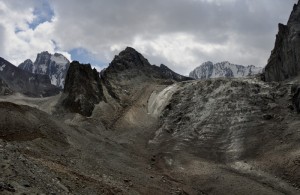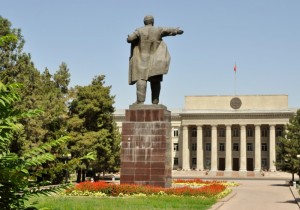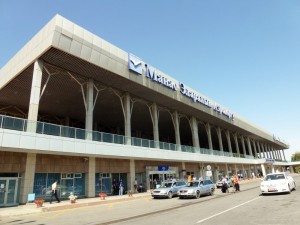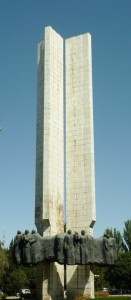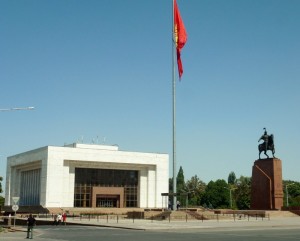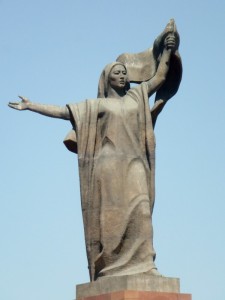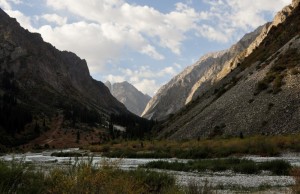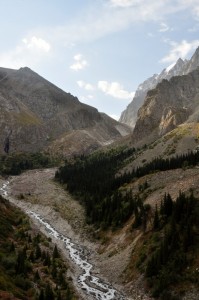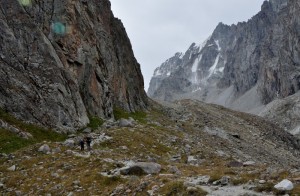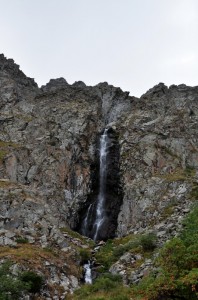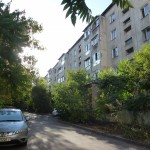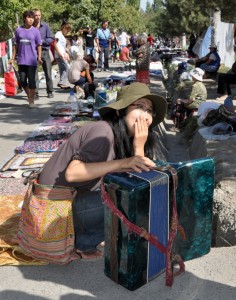My Central Asia journey started when I flew from Novosibirsk, Russia to Bishkek, Kyrgyzstan on August 19. I had a week on my own before joining a 30-day Central Asia Silk Road trip starting on August 26. I wasted three days in getting a visa for Uzbekistan and spent two lovely days in the Ala-Archa National Park.
Background
Kyrgyzstan is a landlocked country with an area of 199,000 square kilometres and a population of about 5.6 million. It is a nation defined by its topography. Tien Shan (Mountain of Heaven) extends from northwest China through Kyrgyzstan to its western borders with Kazakhstan and Uzbekistan. The altitude in Kyrgyzstan ranges from 401m to 7,437m at the summit of Jengish Chokosu and over 90% of the territory is above 1,500m and 41% above 3,000m.
Brief history
The earliest recorded residents of the present day Kyrgyzstan were warrior clans of Saka (also known as Scythians), from about the 6th century BC to the 5th centuries AD. The region was under the control of various Turkic alliances from 6th to 10th centuries AD. The Karakhanids ruled from the 10th to 12th centuries.
Ancestors of today’s Kyrgyz people began to migrate from Siberia south into Tien Shan. Then the Mongols rose to power under Genghis Khan in the 13th century and his second son, Chaghatai inherited today’s Kyrgyzstan in 1227. The Kyrgyz tribes were overrun by the Mongol Oyrats of the Zhungarian Empire (1635-1758) in the 17th century, by the Chinese in middle of the 18th century and by the Uzbeks of the Khanate of Kokand in early 19th century.
Russians came to settle around 1860s. Some local clan leaders sought Russian protection against the ruthless khanate of Kokand. Gradually the present day Kyrgyzstan was eased into the Tsar’s empire. In 1918, Kyrgyz lands became part of the Turkestan Autonomous Soviet Socialist Republic within the Russian Federation. In 1924, it became part of Kara-Kyrgyz Autonomous Oblast (province). In 1926, a Kyrgyz Autonomous Soviet Socialist Republic was formed and became a full Soviet Republic in December 1936.
During the Soviet era, the country went through collectivization, political repression and purges. Russia developed naval weapons at the Lake Issyk-Kol and mined uranium in remote parts of Kyrgyzstan. But Russia had also invested in social infrastructure including roads, communal facilities, schools, medical stations, electricity, sewers and phone links thus improving the standard of living.
Independence came in 1991. Kyrgyzstan has since gone through a turbulent and unstable time as politics are marred by clan and regional loyalties and corruption. Askar Akayev, the first elected President in 1991 was ousted following the Tulip Revolution in 2005. Kutmanbek Bakiyev became the second President and fled after another revolution in 2011. Roza Otunbayeva became an interim president and Almazbek Atambayev became the fourth president in December 2011. Clashes between the two main ethnic groups – Uzbeks and Kyrgyz, are also posing real threats to nationhood and unity. Since 1989 there has been a major exodus of Slavs and Germans (estimated to be over 300,000). The economic and infrastructural developments have been slow. It is estimated about one third of the population is living below the poverty line.
There are about 80 ethnic groups living in the country. Ethnic Kyrgyz makes up 66% of the population. Uzbeks and Russians comprise 14% and 11% of the population respectively. There are also Ukrainians, Uighurs, Tatars, Kazakhs, Tajiks and Koreans who were deported from Sakhalin and Vladivostok in the Russian Far East between 1931 and 1945. Islam is the main religion. Two thirds of the population live and work in rural areas.
August 19 (Sunday): Novosibirsk, Russia – Bishkek, Kyrgyzstan (GMT+5)
I joined a 30-day overland tour with Dragoman starting on August 26. My visa for Russia expired on August 19 and I decided to go direct to Bishkek to wait for the group.
I had a lunch-cum-dinner at a restaurant close to the hotel. The grilled lamb with a cold beer helped and I felt better. In the evening, I met Penny and Tim from Australia who had just returned from a strenuous trek. They told me about their 14-day trip including trekking for eight days and a helicopter trip from a base camp to Karakol. Though they had a guide and three porters, they still had to carry their own backpack. Penny was hurt by falling stones on the second day of the trek but managed to complete a very demanding trek. What has frightened her most is however the falling boulders including some close to their tent.
I saw a leaflet on a 4-day helicopter trip to Lenin Peak (+7000m) base camp from August 22 to 25 for 350 Euros. If I could obtain my visa the following day, I would join this trip.
August 21: Bishkek – Another lost day!
I was back at the Uzbekistan Embassy at 9:30am. There were already half a dozen people waiting outside. At 10am, a lady came out and announced some names. My name was not called.
I doubted whether they would take my application. I therefore walked to Novimad again to see what I should do. A lady tried to call the consular section around 11am and was told to try again at noon. We tried but the lady failed to contact anyone at the embassy. I decided to walk back immediately before the consular section closed at 1pm. I hoped to speak to them direct. I failed and the staff insisted that I must call after 2pm to make an appointment.
I am frustrated. If Dragoman or Novimad had provided the information to me before hand, I could have called from Russia to make an appointment. Or Novimad with my details could have made a call for me on Friday, August 17. I was in no mood to go sightseeing and stayed at the hotel.
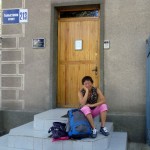 It took me 30 minutes to walk to the Embassy. My name was called at 10am but I had to wait for almost an hour and a half for my turn. As I had an invitation letter, I got my visa on the spot after paying US$75. I was relieved as the local agent had told me that the visa might be issued the next day (again misinformation!)Ala-Archa National Park
It took me 30 minutes to walk to the Embassy. My name was called at 10am but I had to wait for almost an hour and a half for my turn. As I had an invitation letter, I got my visa on the spot after paying US$75. I was relieved as the local agent had told me that the visa might be issued the next day (again misinformation!)Ala-Archa National ParkAs the helicopter for the Lenin Peak base camp had departed at 9am, I had to find something to do. The Ala-Archa National Park which is 40km south of Bishkek looked interesting. I had a difficult time communicating with a taxi driver to agree on a fare. Finally I paid him 1,000som plus 260som for him and his car to enter the park. Apparently it was his first ever trip to the Park. I told him he should use this opportunity to see the park. As he is a nice guy, I also gave him a tip.
There is a modern hotel which charged 5,000som a night. It is overpriced. I decided to take an old style cabin with toilet and hot shower for 2,000som. It was almost 2pm when I settled down.
The park is 4,000 hectares boosting some 600 species of plants. It also has snow leopards, lynxes, Himalayan griffons, ibexes etc. There are several interesting walks as well as challenging climbs for the alpinists. Given my limitations (i.e. without walking boots and poles), I decided to take a 5-10km walk along the river to the upper riverhead of the Ala River and another 6.5-km hike to a waterfall and the Ratsik’s hut (3315m).
August 23: Ala-Archa National Park
I had a breakfast with bread, porridge and tea for 110som and set off at 8:30am. I changed into my sandals when I reached the river plain. After crossing a main stream, I put my shoes on again. It was a big mistake as I had more streams to cross. Then I fell into the water as my legs are too short and the stream is wider than I thought. Luckily I saved my Nikon camera as the water was not too deep though my pants and shoes were all wet. I found out that my shoes are excellent as they remain comfortable and light. (I brought a similar pair on my return to Bishkek on August 25).
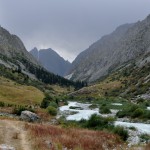 I followed the trail on the left bank of the river for over one kilometre. It got harder with tumbling boulders brought down by landslides. I was struggling when I heard whistles. A group of trekkers across the river used their walking poles to signal me to turn back. I followed their instruction, walked all the way back and found a wooden bridge hidden by trees! Oh God, there is no signage and three trekkers before me had also been advised by this group to turn back and cross at the bridge.
I followed the trail on the left bank of the river for over one kilometre. It got harder with tumbling boulders brought down by landslides. I was struggling when I heard whistles. A group of trekkers across the river used their walking poles to signal me to turn back. I followed their instruction, walked all the way back and found a wooden bridge hidden by trees! Oh God, there is no signage and three trekkers before me had also been advised by this group to turn back and cross at the bridge.
It was noon. The sky turned cloudy with a few drops of rain. The leader of the group said that there might some light rain but the weather should be fine possibly with sunshine in two hours’ time. I decided to cross the bridge and continue with my trek.
After about 10 minutes’ walk, it started to rain with thunder. The sky darkened and I could hardly see the peak. I was scared. As a single traveller, I always put safety first. I turned back and reached my cabin at 1:15pm.
As I had nothing better to do, I went to the hotel restaurant for lunch. I suddenly heard a conversation in Chinese. I met a family of six from Fuzhou (a couple with their parents and two children) on a private tour. All except the two kids speak Cantonese as they have lived in Hong Kong. What a small world!
I was frustrated to see the blue sky and sunshine after 3pm. I was told there is an 8-km loop walk to see an alpinist cemetery and an ascent to the Adegine gorge. The information about the starting point of the trail is confusing and I decided to stay in the cabin for the rest of the day.
August 24: Ala-Archa National Park – Bishkek
I was determined to go ahead with the 6.5-km trek to the waterfall and the Ratsik’s hut. As the weather seemed to be better in the morning, I decided to have an early start. I left my stuff with the hotel receptionist and set off around 7:30am.
I started at 2150m. The trail is well-signed. The first 3.5km to the waterfall is manageable without walking poles. But after that, the climb to the top of the moraine is challenging even with walking poles. I met Guillame from France after visiting the waterfall. He studied at the University of Hong Kong in 2008 and had his Master’s Degree in Engineering. What a small world! I then met Ilana and Hagat from Israel. But they were too tired and did not make to the hut.
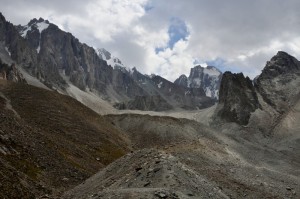 |
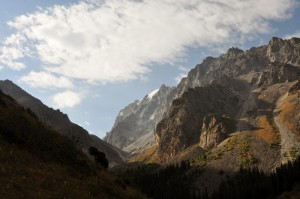 |
I struggled but managed to reach the hut before 12noon. I was rewarded with the most breath-taking views of rugged peaks of the Aksai cirque including Comsomolec Peak (4200m), Corona Pak, Free Korea Peak, Ychitel Peak (4200m) and the Ak-Sai Glacier. There were a number of tents with trekkers and alpinists who would have a fantastic time scaling these peaks. But I am satisfied with my ascent to the hut given I did not have proper hiking boots.
I started my descent at 12:45pm. On the way down, I met Guillame, Ilana and Hagat again. It was comforting to have them nearby. In case I fell or broke my ankle, I could yell for help! I got back to the hotel at 3:30pm and four of us took a taxi for 1500som to Bishkek. I was too tired to find a hotel and simply went to the South Guesthouse where Iliana and Hagat had stayed before.
It turned out to be an interesting experience. The 72-year-old lady lives in a three-bedroom apartment in an old residential area. Everyone calls her Mama. She has eight beds in two rooms and I paid 200som for a bed a night. The place is popular with Japanese backpackers and I met five young Japanese (three girls and two men) who have been travelling for months in Central Asia.
August 25: Bishkek
In the morning, Ryoko, who has been staying in Kyrgyzstan for seven months, took me to a nearby flea market. While working for a textile company, she discovered her talents and interest in weaving. Hence her hobby turns into a career and she makes obi (a sash) for a living. She loves travelling and has been on the road since the end of 2011. She is cheerful and caring and is planning to return to Japan in October and to attend a special course on weaving for three months. I admire her curiosity and stamina and hope to meet up in November in Japan. I then met Olivier, a funny and talkative Belgian who describes himself as a bit crazy. He has been living in China for six years and has spent many holidays in Hong Kong. We spoke in Chinese, English and French!
After visiting the flea market, I went to the Frunze House Museum, the National History Museum and then the State Museum of Fine Arts before going to the Vera Centre to buy another pair of Geox shoes. I was totally exhausted when I got back to the guesthouse. For the first time on this trip, I cooked myself a pack of instant noodle. (End of the first part)
Remarks
I wasted three days in getting a visa for Uzbekistan. My first week in Kyrgyzstan could have been better spent in exploring the country.
Anyway, I had a relaxing and fruitful time. First, I completed uploading photos from my Kamchatka trip. Second, I brought two pairs of comfortable walking shoes. Third, I had a challenging trek and managed to reach the Ratsik’s hut. Fourth, I am glad to meet nice people like Penny, Tim and Ryoko and hope to see them again.


